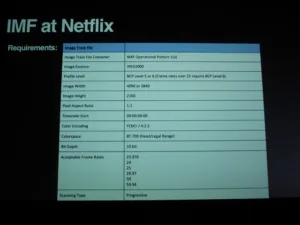Mike Whipple and Sean Durkin are from Netflix and discussed the process of sourcing content, and producing originals, for the service.

 Because much of Netflix’s content comes from external sources like broadcasters, the company has to deal with a huge number of different formats, most of them closed and proprietary. Some are legacy formats, which limits innovation. 12% of titles submitted to Netflix are rejected because they use incompatible formats (‘versionitis’).
Because much of Netflix’s content comes from external sources like broadcasters, the company has to deal with a huge number of different formats, most of them closed and proprietary. Some are legacy formats, which limits innovation. 12% of titles submitted to Netflix are rejected because they use incompatible formats (‘versionitis’).
Netflix is today accessible in every country in the world except China, North Korea and Syria. However, quality is not consistent across regions. Other challenges that the post-production team faces include poor quality assets (copies of copies of copies), poor archiving and the need to deal with regional cuts and censorship – no genitalia can be shown in Japan, for example.
The customer experience is evolving. At first, Netflix was showing SD content. After this the service added 720p and 1080p content and 10-bit video. Now it is offering UltraHD and some HDR. As well as the content itself changing, how Netflix is watched has changed. At launch, the service was mainly accessed through web browsers; now it is mainly done through smart TVs, game consoles and mobile devices. Around 53 different streams are created for every single piece of content to support all of these devices (more than 1,200).
Because of the many ways in which people access Netflix, adaptive bitrates are important, as are future-proof file formats. The Interoperable Master Format (a standard under development by SMPTE) is based on open and common standards like XML; it can be used to generate multiple deliverables from a single package, or to edit or update a stream that is already finished. It supports multiple languages and reels, subtitles, closed captions and other ‘DVD-like’ features. Netflix has been accepting IMF as a format since 2014.

